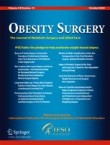
Abstract
Introduction
Post-bariatric surgery hypoglycemia is usually seen in patients with a history of gastric bypass surgery [1], and few experience severe symptoms [2]. The pathophysiology of post-gastric bypass surgery hypoglycemia is not well understood, and many theories have been proposed: excessive GLP-1, nesidioblastosis, and increased glucose effectiveness [3]. Thus, the etiology of this condition is complex. Laparoscopic GBP reversal is a very unusual procedure and indications may include excessive weight loss, unexplained GI tract symptoms, and severe hypoglycemia. Hypoglycemia should be managed non-surgically at first, but in case of medical therapy failure, surgical options may be considered. Surgical options include gastrostomy tube placement, gastric bypass reversal [4], or gastric bypass reversal with concomitant sleeve gastrectomy [5–7]. A partial reversal was also mentioned in the lite rature [6]. Laparoscopic conversion to a sleeve gastrectomy for hypoglycemia is unusual and converting an open gastric bypass to a laparoscopic sleeve gastrectomy is exceptional, even never reported. In this video (run time 6 min and 48 s), we present our procedure, which was performed by adopting a new technique.
Patient and Methods
A 52-year-old lady was referred to us for hypoglycemia following an open gastric bypass revision that was done in 2012. Her past surgical history includes 2 laparoscopic gastric band surgeries with subsequent removal of the bands, open bypass surgery in 2007 and open bypass surgery revision in 2012. History goes back to 12 months ago when the patient started complaining of fatigue, lassitude, and symptoms consistent with Whipple's triad. OGTT (oral glucose tolerance test) showed low glucose levels at 2 h (2.7 mmol/l) and at 3 h (3.3 mmol/l). Serum insulin level and C-peptide were normal. The patient was diagnosed as having early dumping syndrome (reactive hypoglycemia). She was started on sitagliptin 1 tab once daily with dietary changes. Despite this management, she was hospitalized several times for worsening of her symptoms. When referred to our department, the patient asked about the possibility of a laparoscopic intervention, sin ce she has suffered a lot from her previous laparotomy incisions. The laparoscopic surgery intervention was discussed with the patient and it was a challenging option in this case. The patient was placed in the lithotomy position with the surgeon standing between the patient's legs. An 11-mm trocar was inserted above the umbilicus. Under vision, 4 other trocars were inserted: a 12-mm trocar in the right midclavicular line and three 5-mm trocars in the epigastrium, left anterior axillary line, and left midclavicular line, respectively. We started with adhesiolysis in order to identify the gastro-jejunostomy and to free the abdominal esophagus. A subtle hiatal hernia was also reduced. Then, the jejuno-jejunostomy was identified, and the alimentary limb was measured. The latter was 70 cm in length, and the decision was to resect it, keeping the jejuno-jejunal anastomosis in place. The gastric pouch was divided just above the gastro-jejunal anastomosis. The alimentary limb was th en exteriorized. Then, the gastric remnant was freed from its omental attachment. The gastric remnant and the gastric pouch were calibrated with a 40-Fr Faucher tube, and appropriate sequential firing was done using endo-GIA. A gastro-gastrostomy was fashioned by the end of the sleeve division to create the gastric tube.
Results
The operative time was 245 min, with minor blood loss (less than 250 cc). The perioperative course was uneventful, with no intra-operative or post-operative morbidity. An upper GI series was done on post-operative day 2 and showed no evidence of leak. It has been 11 months since the procedure and the patient has become normoglycemic. Her last FBS was 4.4 mmol and she is currently free of symptoms.
Discussion and Conclusion
Post-bariatric surgery hypoglycemia is a challenging condition, for both surgeons and endocrinologists. Our patient has suffered severe symptoms that were refractory to medical treatment and dietary modifications. Few papers have discussed LGBP conversion to a sleeve gastrectomy for hypoglycemia, but results from small series are showing promising results. Our case was challenging because of the patient's previous multiple open surgeries and the technique we have adopted is unique, since we have fashioned the sleeve by firing 2 separate gastric pouches (gastric pouch and gastric remnant) to create a gastric tube and by performing a gastro-gastrostomy with intra-corporeal sutures.












